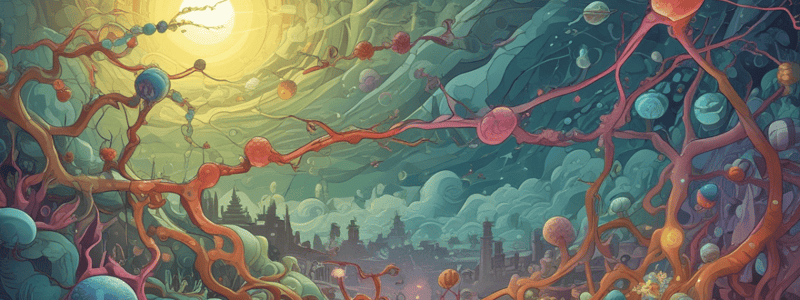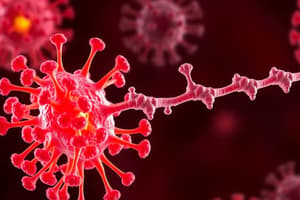Podcast
Questions and Answers
Which type of receptor does not use a secondary messenger?
Which type of receptor does not use a secondary messenger?
- α1-adrenergic receptor
- Phospholipase C
- Receptor tyrosine kinase (RTK) (correct)
- G-protein coupled receptor (GPCR)
What is the function of Grb2 and Sos adaptor proteins?
What is the function of Grb2 and Sos adaptor proteins?
- To activate the Ras-MAP kinase pathway
- To inhibit the EGF signalling pathway
- To phosphorylate tyrosine residues
- To bind to the receptor tyrosine kinase (correct)
What is the consequence of adrenaline binding to the α1-adrenergic receptor?
What is the consequence of adrenaline binding to the α1-adrenergic receptor?
- Autophosphorylation of tyrosine residues
- Inhibition of the EGF signalling pathway (correct)
- Activation of phospholipase C
- Activation of the Ras-MAP kinase pathway
What is the role of Ras in the EGF signalling pathway?
What is the role of Ras in the EGF signalling pathway?
What is an example of convergence in cell signalling?
What is an example of convergence in cell signalling?
What is the role of MAPKK in the Ras-MAP kinase pathway?
What is the role of MAPKK in the Ras-MAP kinase pathway?
What is the function of PKA in the adrenaline signalling pathway?
What is the function of PKA in the adrenaline signalling pathway?
What is the consequence of EGF binding to the EGF receptor?
What is the consequence of EGF binding to the EGF receptor?
What is the primary function of transmembrane receptors in signal transduction pathways?
What is the primary function of transmembrane receptors in signal transduction pathways?
Which of the following is NOT an example of a second messenger?
Which of the following is NOT an example of a second messenger?
What is the primary role of G proteins in signal transduction pathways?
What is the primary role of G proteins in signal transduction pathways?
Which of the following is an example of a metabolic process regulated via intracellular signalling?
Which of the following is an example of a metabolic process regulated via intracellular signalling?
What is the primary role of phospholipase C in signal transduction pathways?
What is the primary role of phospholipase C in signal transduction pathways?
Which of the following is an example of a cellular response to an extracellular signal?
Which of the following is an example of a cellular response to an extracellular signal?
What is the primary function of receptor tyrosine kinases (RTKs) in signal transduction pathways?
What is the primary function of receptor tyrosine kinases (RTKs) in signal transduction pathways?
Which of the following is an example of an extracellular signal?
Which of the following is an example of an extracellular signal?
What is the result of the binding of a signal molecule to a β-adrenergic receptor?
What is the result of the binding of a signal molecule to a β-adrenergic receptor?
What is the function of the α subunit in the G-protein complex?
What is the function of the α subunit in the G-protein complex?
What is the result of GTP hydrolysis to GDP in the G-protein complex?
What is the result of GTP hydrolysis to GDP in the G-protein complex?
What is the role of the G-protein in the β-adrenergic receptor signalling pathway?
What is the role of the G-protein in the β-adrenergic receptor signalling pathway?
What is the result of the dissociation of the G-protein complex?
What is the result of the dissociation of the G-protein complex?
What is the role of GDP in the G-protein complex?
What is the role of GDP in the G-protein complex?
Which of the following hormone types binds to a receptor in the cytosol and triggers a response inside the cell?
Which of the following hormone types binds to a receptor in the cytosol and triggers a response inside the cell?
What is the result of the binding of acetylcholine to nicotinic acetylcholine receptor?
What is the result of the binding of acetylcholine to nicotinic acetylcholine receptor?
What is the function of the DNA binding domain in steroid hormones?
What is the function of the DNA binding domain in steroid hormones?
What is the consequence of the binding of steroid hormone to its receptor?
What is the consequence of the binding of steroid hormone to its receptor?
What is the role of G-protein-coupled receptors (GPCRs) in cell signalling?
What is the role of G-protein-coupled receptors (GPCRs) in cell signalling?
What is the consequence of the activation of adenylyl cyclase by G-protein-coupled receptors (GPCRs)?
What is the consequence of the activation of adenylyl cyclase by G-protein-coupled receptors (GPCRs)?
What is the function of the hormone binding domain in steroid hormones?
What is the function of the hormone binding domain in steroid hormones?
What is the consequence of the activation of phospholipase C by G-protein-coupled receptors (GPCRs)?
What is the consequence of the activation of phospholipase C by G-protein-coupled receptors (GPCRs)?
What is the consequence of GTP hydrolysis in the G-protein coupled receptor signalling pathway?
What is the consequence of GTP hydrolysis in the G-protein coupled receptor signalling pathway?
What is the role of the regulatory subunit in the cAMP dependent protein kinase A (PKA) pathway?
What is the role of the regulatory subunit in the cAMP dependent protein kinase A (PKA) pathway?
What is the consequence of phosphorylase kinase activation in the glycogen breakdown pathway?
What is the consequence of phosphorylase kinase activation in the glycogen breakdown pathway?
What is the role of phosphodiesterase in the cAMP signalling pathway?
What is the role of phosphodiesterase in the cAMP signalling pathway?
What is the consequence of CREB phosphorylation in the cAMP signalling pathway?
What is the consequence of CREB phosphorylation in the cAMP signalling pathway?
What is the role of Gαq in the GPCR signalling pathway?
What is the role of Gαq in the GPCR signalling pathway?
What is the role of IP3 in the GPCR signalling pathway?
What is the role of IP3 in the GPCR signalling pathway?
What is the consequence of DAG and Ca2+ activation in the GPCR signalling pathway?
What is the consequence of DAG and Ca2+ activation in the GPCR signalling pathway?
What is the role of cAMP in the signal amplification pathway?
What is the role of cAMP in the signal amplification pathway?
What is the consequence of PKA activation in the signal amplification pathway?
What is the consequence of PKA activation in the signal amplification pathway?
Flashcards are hidden until you start studying
Study Notes
Receptor Activation of Phospholipase C
- α1-adrenergic (adrenaline) receptor directly activates enzymatic kinase cascade without secondary messenger
- Binding of EGF triggers autophosphorylation of tyrosine residues in cytoplasmic domain of receptor (Receptor Tyrosine Kinase, RTK)
- Adaptor proteins containing phosphotyrosine binding domains (SH2 and PTB) bind to receptor
- Complex of Grb2, Sos, and receptor activates Ras, a monomeric G-protein
- Ras triggers a kinase cascade (Ras-MAP kinase pathway) that activates transcription factor
G-Protein Coupled Receptors (GPCR)
- Generate cAMP, leading to activation of PKA
- Generate IP3, DAG, and Ca2+, leading to activation of PKC
- α-subunit of G-protein interacts with effector enzymes
- G-proteins can trigger different pathways, causing convergence and cross-talk
Intracellular Signalling
- Cells respond to extracellular signals through G-protein coupled receptors (GPCR) and receptor tyrosine kinase (RTK)
- GPCR can trigger different pathways, leading to convergence and cross-talk
- Different signals can trigger different pathways, causing overlap and cross-talk
Teaching Objectives
- Describe different ways for cells to signal to each other
- Explain the term 'second messenger' and give examples
- Describe the importance of transmembrane receptors and their associated signalling pathways in controlling gene activity
- Give examples of the roles of G proteins, cAMP, phospholipase C, diacylglycerol, inositol triphosphate (IP3), and Receptor Tyrosine Kinase (RTK) in signal transduction pathways
- Outline a metabolic regulated via intracellular signalling
- Recognise that overlap of signalling pathways can occur
- Beware that intracellular signalling is important in the action of drugs
Cellular Responses
- Change metabolic activities
- Secrete and release molecules
- Changes in gene expression
- Sensory perception
Studying That Suits You
Use AI to generate personalized quizzes and flashcards to suit your learning preferences.




